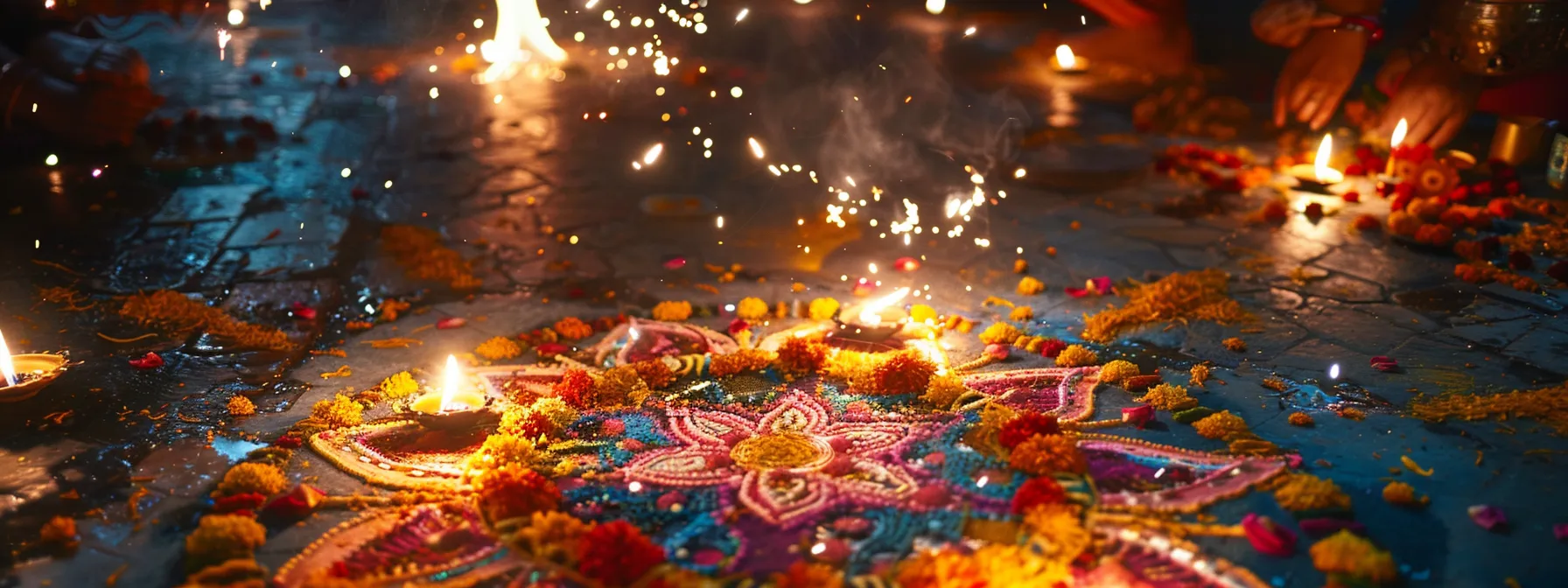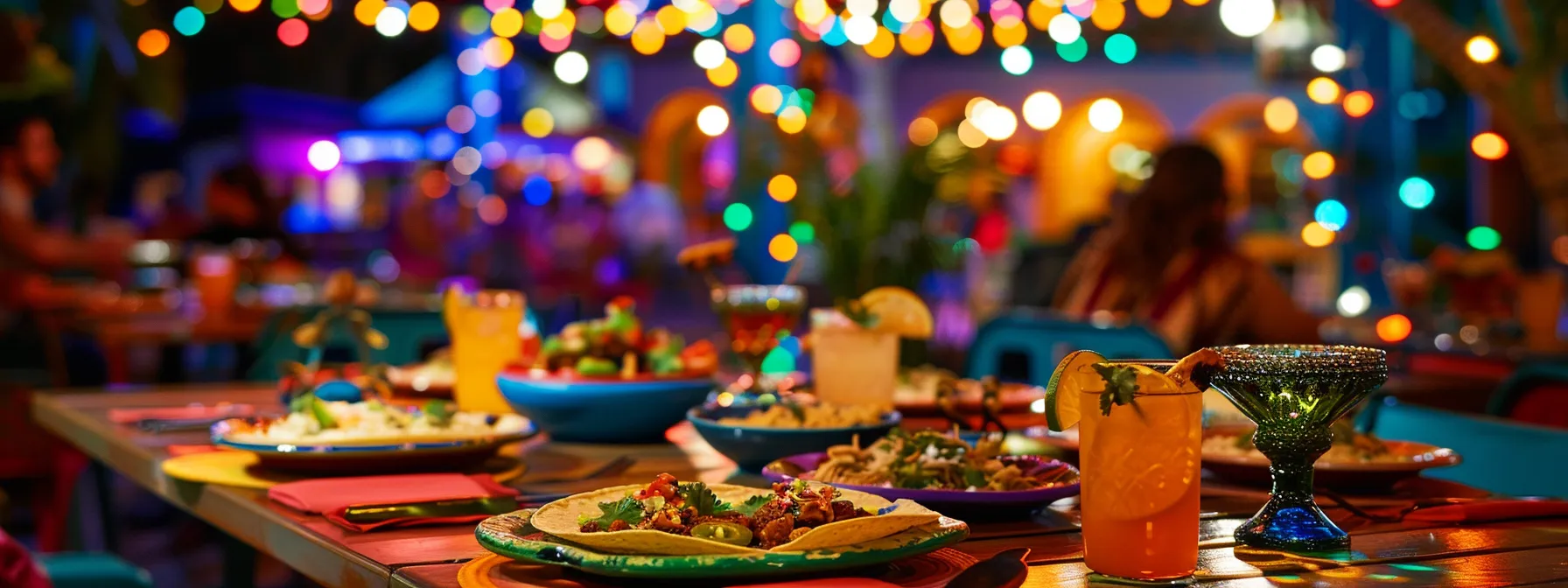Diwali, known as the Festival of Lights, transcends borders, illuminating hearts worldwide with its message of victory of light over darkness. This vibrant festival, deeply rooted in Hinduism, is not just India’s luminous gem but a global celebration, adopting unique customs from one country to the next. Our journey will take us through the beloved traditions, the sumptuous feasts that mark the occasion, and the central ritual of Laxmi Puja, where devotees honor the goddess Lakshmi, the embodiment of wealth and prosperity. Readers keen on experiencing the richness of Diwali will learn about decorating homes with lights and rangoli, and how to partake in the festivities, no matter where they are. By delving into this post, you’ll enrich your understanding of this enchanting festival and discover ways to celebrate Diwali’s splendid heritage in your community.
Understanding the Significance of Diwali Around the World
As we delve into the significance of Diwali, we uncover its historical roots, tracing back to the epic return of Lord Rama, an essential story for Hindus worldwide. The spiritual essence of this festival illuminates the triumph of good over evil, unity, and hope. Through the diverse customs such as creating colorful rangoli, and the Laxmi Puja ritual, to the grand festivities in places like Leicester, where Jainism also finds affinity with the occasion, we see a tapestry of traditions. Our exploration will reveal common themes spanning continents, reflecting why Diwali resonates so profoundly across cultures.
Exploring the Historical Origins of Diwali
In my research into the roots of Diwali, I’ve learned that this festival of lights has a rich heritage tied to the Hindu epic of the Ramayana. The tradition of lighting oil lamps signifies the victory of Lord Rama over the demon king Ravana, fulfilling a quest to rescue his wife Sita. This act symbolizes the broader theme of light banishing darkness, embodying a universal celebration of righteousness and bravery across different cultures.
Moreover, during Diwali, the Hindu deity of wealth and prosperity, Laxmi, is worshipped to invite good fortune and success into homes. The Laxmi Puja ritual, an intrinsic part of the festivities, involves families lighting oil lamps and candles around their homes, creating a warm and inviting atmosphere. This ritual reflects not only the spiritual aspirations but also the universal desire for well-being and prosperity that connects diverse cultures in a shared celebration of life’s blessings.
The Spiritual Meaning Behind the Festival of Lights
Within the walls of Hindu temples, both in India and in the United Kingdom, the spiritual ambiance during Diwali is palpable. The festival, it appears to me, is a momentous time when the story of Ayodhya returns to the forefront, reminding worshippers and participants alike about the core values of courage, truth, and the importance of light in dispelling darkness. It’s during these moments, as we honor Goddess Laxmi, that the essence of Diwali’s spiritual meaning shines through, uniting individuals in a harmonious celebration of renewal and purity.
The facts about Diwali are as enlightening as the diyas that flicker in millions of homes, suggesting a profound truth about the power of faith and communal joy. My reflections on the customs observed worldwide reveal an undeniable acknowledgment of the inner light within all beings, a principle that people, irrespective of their background, find affinity with. Embracing the essence of this sacred occasion offers a pathway to deeper self-awareness and a strengthened sense of community across the globe.
Common Themes in Global Diwali Celebrations
As I observe Diwali celebrations around the world, it’s evident that the values of unity and community are universally cherished. Community gatherings are central to the holiday, where people from all walks of life come together to perform the Puja ritual, honor Sita and Rama’s tale, and celebrate the enlightenment of Mahavira. This shared spirit of togetherness speaks to the core of human connection, irrespective of geographic boundaries, making Diwali a deeply resonant festival globally.
The reverence for traditions during Diwali, such as the Laxmi Puja, is a potent reminder of cultural preservation and respect. I’ve seen community halls and homes alike, where the ritual of Puja brings a sense of peace and a desire for prosperity that extends beyond personal gains. Across continents, from lighting diyas to sharing sweets, these practices form a common thread that weaves through the holiday’s fabric, reinforcing the notion that despite our diversity, we all seek the joy and light in life.
Unique Diwali Traditions in Different Countries
Diwali’s reach extends far beyond India’s borders, touching hearts and lighting evenings in every corner of the globe. Each culture adds its unique touch to the festival, from prayer rituals in Nepal to adapting local traditions in the Caribbean. In my exploration of Diwali celebrations, I’ll disclose how different regions—including India, Nepal, Singapore, Malaysia, the Caribbean, the United Kingdom, and North America—embrace this festival. Their practices reflect the diverse expressions of joy, from regional variations within India to Buddhism’s influence in Nepal’s Tihar and the significance of Guru Hargobind’s release for Sikhs. We’ll also tackle concerns like air pollution during the festivities and how cities like London manage to balance tradition with environmental awareness. Understanding these unique customs provides insight into the collective spirit of Diwali and its capacity to bring people together.
Celebrating Diwali in India: Regional Variations
In my travels across India during the Diwali season, I have witnessed how regional variations infuse the festival with local flair. In the northern state of Uttar Pradesh, the ceremonial burning of Ravana effigies marks the conclusion of the ancient Ramleela play, symbolizing the destruction of evil and the restoration of moral order. Meanwhile, the streets of the Golden Mile in Leicester, UK, shimmer with lights and are abuzz with activities, echoing the vibrancy often seen in Indian bazaars, where temple grounds and marketplaces become buzzing nodes of celebrations.
South India’s take on Diwali, particularly Tamil Nadu, is characterized by unique clothing traditions – the vibrant silk sarees and dhotis represent joy and renewal. Before the daybreak, families come together for a traditional oil bath, a ceremony that precedes the Laxmi Puja, reflecting purification and the sanctity of the festivities. The reverence for the temple, family, and community rituals during this time reinforces a profound connection that transcends individual experiences, uniting people in shared spiritual tenor and festivity.
Diwali Festivities in Nepal: Tihar and Its Customs
As I ventured into the heart of Nepal during the Diwali season, I discovered the beautiful festival of Tihar, which brilliantly reflects the nation’s religious diversity and vibrancy. The Hindu calendar marks this time as pivotal; not only for the Laxmi Puja, but also for the celebrations of animals such as dogs and cows, believed to bring luck and prosperity. This tradition showcases the intricate ways that religion and cultural reverence for nature intertwine, offering a unique perspective on the festive customs in Nepal.
In the bustling streets of Kathmandu, I found Tihar to resonate deeply with the sentiment of Diwali yet displaying its distinctive customs. Bandi Chhor Divas, specifically celebrated by the Nepalese Sikh community, commemorates the release of Guru Hargobind from imprisonment and stands as a beacon of hope and freedom. This echoes through the local gatherings, even as far as Northampton, where vibrant community events mirror the ethos of Diwali, cementing the interconnectedness of joy, religion, and shared humanity across borders.
How Singapore and Malaysia Observe Diwali
In Singapore, Diwali, known locally as Deepavali, is a vibrant constellation of lights, feasts, and jovial community spirit. The streets of Little India are a testament to the island’s rich tapestry of cultures, with their flamboyant decorations and the scent of burning oil lamps wafting in the air, signifying the victory of Krishna over the demon Narakasura. As people come together in shared faith, I often find the bustling markets and entertainment stages alive with cultural performances, which offer a feast for the senses and reinforce the significance of communal harmony.
Across the strait in Malaysia, Diwali manifests itself with equal fervor. The ritual of the Laxmi Puja is conducted in homes with oil lamps setting a serene ambiance, an antidote to the bustling city life. Though concerns about pollution have led to an increasing awareness of eco-friendly practices, the dedication to preserving the essence of Diwali continues. My experience in the thriving Indian Malaysian communities underscores the enduring strength of tradition, where faith and familial bonds take center stage, showcasing the resilience of cultural practices even in the face of modern environmental challenges.
Diwali in the Caribbean: A Blend of Cultures
In the Caribbean, Diwali ushers in a jubilant blend of cultures, where the Laxmi Puja is a central highlight. As a fusion of Indian traditions and local flair, lighting deyas, small clay lamps, symbolizes the presence of Hindu deities and the wish for divine blessings. This religious festival, despite being miles away from India, outshines the geographical divide, fostering a sense of community amongst Caribbean Hindus.
Efforts by organizations like the Leicester City Council to promote and support multicultural events inspire me. These initiatives ensure that the essence of Diwali, and the observance of rituals like the Lakshmi Puja, retain their spiritual significance while adapting to the diversity of the region. It’s this universal embrace of light over darkness that solidifies Diwali’s profound impact on the Caribbean’s cultural tapestry.
Observing Diwali in the United Kingdom and North America
In the United Kingdom, Diwali celebrations are a dazzling showcase of multiculturalism where traditional Indian cuisine and sari dressing underscore the cosmopolitan fabric of cities like London and Leicester. Benevolent deities vanquishing demons, a central theme of the festival’s Sanskrit tales, are brought to life through spirited dance performances that enrapture audiences, signifying the perennial struggle between good and evil.
Across the Atlantic, in North America, the observance of the Laxmi Puja ritual during Diwali unites Indian communities, affirming their cultural heritage amidst a modern backdrop. Homes glow with the warmth of oil lamps, fragrant with spices, as families gather, reciting prayers and celebrating the goddess of wealth with a fusion of time-honored tradition and contemporary festivities.
The Laxmi Puja Ritual: Honoring the Goddess of Wealth
The Laxmi Puja is a pivotal element of Diwali, marking respect for the goddess of wealth and prosperity. Preparations begin with meticulous cleaning and the embellishment of spaces to welcome her. Engaging step-by-step rituals, families gather essential items, including the sweet laddu as an offering. Addressing Laxmi with traditional prayers and mantras, I find this practice deeply embedded in current celebrations, symbolizing aspirations for success and financial stability.
Preparing for Laxmi Puja: Cleaning and Decoration
In my experience, preparing for the Laxmi Puja begins with a deep clean, a process that signifies the removal of negativity to create a welcoming environment for the Goddess of Wealth. This thorough tidying is not just a physical act but a mental preparation, setting the stage for positive energy to flow into the lives and homes of the faithful during Diwali.
Decorating the space plays a pivotal role in the Laxmi Puja, involving the artful arrangement of oil lamps, flowers, and colorful rangoli designs that serve as a sacred invitation to the goddess. This harmonious blend of aesthetics and spirituality transforms an ordinary setting into a divine sanctuary, where the hopes for prosperity and good fortune are expressed through visual beauty and reverence.
Essential Items Needed for Laxmi Puja
When I prepare for the Laxmi Puja during Diwali, the essentials involve a variety of items that have deep spiritual significance. A traditional earthen lamp, known as a diya, is a must, symbolizing the light of knowledge and consciousness that Laxmi brings into our lives. Alongside, incense sticks and fresh flowers are arranged as offerings to create a fragrant, inviting atmosphere for worship.
The presence of a clean, new cloth is important to lay as the base for the idol or image of Goddess Laxmi, signifying purity and respect. Currency notes and coins are also integral, representing the material wealth we pray for, but there’s always a sense of humility, knowing that prosperity flows from the divine blessings of Laxmi into our lives through sincere devotion and moral living.
Step-by-Step Guide to Performing Laxmi Puja
To commence the Laxmi Puja during Diwali, I begin with the most essential step: setting the intention for the ritual. This is a moment of quiet reflection where I focus on Laxmi’s divine qualities of prosperity, generosity, and the wealth of wisdom. I then light the diya, an earthen lamp, inviting the Goddess into my home. The flickering flame symbolizes enlightenment and the banishment of shadows, reflecting a hopeful start to the year ahead.
Following this, I place the idol of Goddess Laxmi on a clean cloth as a mark of respect and purity. I offer fresh flowers and sweets, symbols of the beauty and sweetness of life, to the deity. The ritual unfolds as I recite mantras, a practice that holds great significance, as the vibrational sounds are believed to elevate the ceremony’s spiritual energy. These verses serve as a connection between my aspirations for prosperity and the divine grace of Laxmi.
Traditional Prayers and Mantras for Laxmi Puja
During the Laxmi Puja, I have found that reciting traditional prayers and mantras is a profound experience that resonates deeply within the devotees’ hearts. The “Om Shree Mahalakshmyai Cha Vidmahe Vishnu Patnyai Cha Dheemahi Tanno Lakshmi Prachodayat Om” mantra summons the essence of Laxmi, inviting her blessings for prosperity and wisdom. Realizing the power of these ancient words, I join the countless voices that engage in this sacred practice, creating a spiritual harmony that transcends physical boundaries.
The ritual reaches its pinnacle when I chant the Sri Suktam, a series of hymns in praise of Laxmi, which is believed to attract abundance and purity. Each syllable uttered in devotion becomes a thread in the fabric of faith that binds believers together, exemplifying the universality of seeking divine favor. The mantras, reverberating through the festive ambiance, are a testament to the tradition’s enduring relevance and the comfort it provides to those who partake in it year after year.
Significance of Laxmi Puja in Modern Times
Today, I find the Laxmi Puja not only continues to be a linchpin in the worship during Diwali but it also symbolizes a beacon of hope for financial stability and prosperity in modern households. The ritual adapts to contemporary needs, where seeking divine blessings for business ventures and personal finance resonates deeply with believers, reinforcing the connection between spiritual faith and daily life priorities.
By actively participating in the Laxmi Puja, I have noticed it serves as an anchor, providing cultural continuity and spiritual solace in our fast-paced world. Amidst the technology-driven changes of modernity, this tradition underscores a collective aspiration for health, wealth, and success, proving its enduring relevance and importance in nurturing cultural roots and personal well-being.
Diwali Cuisine: Celebratory Foods Around the Globe
Diwali’s festive spirit extends to a culinary journey that showcases rich flavors and traditions. We’ll delve into the essence of Diwali through its celebratory foods, with a focus on traditional Indian sweets and snacks that have become synonymous with the festival. Exploring regional specialties sheds light on their cultural significance, while adapting these cherished recipes abroad speaks to the ingenuity of the diaspora. Moreover, I’ll share practical tips and ideas for hosting a Diwali feast that captures this global festivity’s essence.
Traditional Indian Sweets and Snacks for Diwali
During Diwali, the air is often fragrant with the aroma of traditional sweets like gulab jamun and jalebi. I find immense joy in preparing these delicacies, which is a common practice in Indian households to mark the celebration. The sweetness of these confections symbolizes the joy and prosperity that Diwali is all about, and sharing them is a gesture of goodwill that strengthens the bonds of community and family.
Families like mine also revel in making savory snacks such as samosas and chaklis. These treats not only add to the gastronomic diversity of the festival but also offer moments of togetherness, as we roll out dough and deep-fry snacks while recounting tales of Diwalis past. This practice is more than just cooking; it’s creating and continuing a handed-down tradition that nourishes both the body and the spirit during this auspicious time.
Regional Specialties and Their Significance
During my exploration of Diwali’s impact on culinary traditions, I’ve observed that regional specialties embody more than flavors; they carry historical significance and communal identity. In West Bengal, for instance, the sweet dish Kheer Kadam, layered with rich khoya and syrupy rasgulla, reflects the local palate and the artisanal prowess of regional confectioners, adding a distinct dimension to the festival’s gastronomy. Each bite of these confections is a tribute to history and an affirmation of the region’s role in Diwali’s celebratory narrative.
In Maharashtra, the multi-layered sweet, Puran Poli, becomes a culinary centerpiece during Diwali, signifying indulgence and the season’s prosperity. As I partake in the meticulous preparation of this dish, rolling out dough and stuffing it with jaggery-sweetened gram flour, I am reminded of the unity food brings as families gather to engage in this shared labor of love. This unifying experience is echoed in households across the region, reinforcing the community’s bonds and the culinary heritage that Diwali so vividly celebrates.
Adapting Diwali Recipes Abroad
Adapting cherished Diwali recipes while overseas has been an inventive journey for me. Utilizing local ingredients to recreate the flavors of traditional Indian sweets and snacks requires both creativity and flexibility. This often means substituting ghee with butter or using honey as an alternative to jaggery, ensuring these delicacies retain their festive spirit even when far from home.
In my own kitchen, I’ve learned that bringing a taste of Diwali to a foreign land involves more than just mimicking tried-and-true recipes. It’s about preserving the essence of the celebration—joy, sharing, and togetherness. I have experienced how making Diwali treats with friends and neighbors introduces them to our rich culinary culture and fosters a sense of communal warmth, making every adapted recipe a bridge between cultures.
Hosting a Diwali Feast: Tips and Ideas
When I host a Diwali feast, my focus is on creating an inviting ambiance and a menu that caters to diverse palates. Choosing a central theme, such as regional Indian cuisines or a vegetarian spread, helps organize the meal and offers guests a cohesive culinary experience. I ensure each dish, from savory appetizers to sweet desserts, is prepared with care, using fresh ingredients that capture the essence of the festival.
During the gathering, it’s essential to balance tradition with convenience—opt for make-ahead items and family-style servings to minimize last-minute preparations. As the host, I find my enjoyment in the festivities increases when I’m able to join my guests, rather than spending all my time in the kitchen. By planning ahead and incorporating these tips, I aim to host a Diwali feast that’s memorable for both the delicious cuisine and the shared warmth of community.
Decorating for Diwali: Lights, Rangoli, and More
As we celebrate Diwali, the festival of lights, decorating our homes becomes a joyful expression of the season. I’ve learned that creating intricate rangoli designs on the doorstep welcomes guests and embodies the festive spirit. Brightening our spaces with innovative lighting arrangements sets the mood, while incorporating eco-friendly decorations aligns with the more environmentally-conscious ethos of today’s world. Each element of Diwali decor, from the humble diya to the vibrant rangoli, carries deep symbolism, reflecting the festival’s core themes of light, knowledge, and good fortune.
The Art of Creating Rangoli Designs
In my exploration of Diwali traditions, I’ve discovered that the art of creating rangoli designs is a significant part of the decoration process. These patterns, crafted on floors using vibrant powders or flowers, are not just an embellishment but a sacred welcoming gesture for Goddess Laxmi. Crafted meticulously by hand, rangoli instills a sense of sanctity and convivial beauty at the thresholds of homes and temples, embodying the festival’s spirit of warmth and inclusivity.
When I set out to create a rangoli, the process begins with conceptualizing a design that complements the festive ambiance. Choosing colors that represent prosperity, peace, and fertility—typically reds, yellows, greens, and whites—adds to the auspiciousness of the artwork. The act of bending down to pour the powder gently onto the ground becomes a humble tribute to Mother Earth, making rangoli an interplay of cultural reverence and creative expression during the Diwali celebrations.
Innovative Lighting Ideas to Brighten Your Home
In my quest to brighten up my home for Diwali, I’ve turned to LED string lights, which offer a versatile and energy-efficient solution. By draping these around windows and doorways or shaping them into inspiring designs, I’ve managed to create an enchanting light display that captures the true essence of the Festival of Lights. Integrating color-changing bulbs adds an extra dimension, allowing me to reflect the vibrant hues that are synonymous with Diwali celebrations.
Additionally, I’ve found that handcrafted lanterns infuse a traditional touch while imbuing my space with a soft, warm glow. Placing these luminaries in clusters at varying heights around the living area creates a captivating visual impact and serves as a nod to Diwali’s time-honored customs. Crafting these lanterns at home has also provided a gratifying and personal touch to my festive decor, highlighting the joy of Diwali through shared creativity and DIY ingenuity.
Incorporating Eco-Friendly Decorations
In my efforts to honor Diwali’s ethos while being mindful of environmental impact, I’ve embraced eco-friendly decorations that are both meaningful and sustainable. Incorporating biodegradable lanterns and rangoli colors derived from natural, non-toxic substances, I contribute to a greener celebration. This approach not only helps in reducing the carbon footprint associated with the festival but also sets a precedent for future celebrations that prioritize ecological well-being.
I’ve also noticed a growing trend in using solar-powered lights during Diwali, a testament to the innovative ways we can intertwine tradition with environmental stewardship. By choosing these renewable energy options over conventional lights, I not only celebrate the festival of lights in its true essence but also do my part in conserving energy. It’s a simple yet powerful way to ensure that while we illuminate our homes, we’re also casting light on the importance of preserving our planet for generations to come.
Symbolism Behind Diwali Decor Elements
My experience in celebrating Diwali has shown me that every decor element carries with it a profound meaning, contributing to the festival’s spiritual depth. The earthen diyas, for instance, illuminate our homes with their modest glow, symbolizing the eradication of spiritual ignorance and the awakening of divine light within us. These tiny flames remind us that light will always prevail over darkness, an encouraging thought that resonates globally.
Moreover, the vibrant rangoli designs adorning entrances embody more than artistic expression; they are emblematic of joy, auspiciousness, and the invitation of positive energy into our homes. As I carefully lay out patterns using colorful powders and flower petals, I’m engaging in an act of celebration that honors prosperity and hospitality, two principles that Diwali champions, no matter where it’s observed in the world.
Participating in Diwali Celebrations Worldwide
Partaking in Diwali festivities provides a splendid opportunity to engage with cultural traditions and create communal bonds. I’ve found that locating local events and understanding celebration etiquette can vastly enhance the experience. Making Diwali activities accessible for children is equally vital, as it ensures the passage of these rich customs to younger generations. Additionally, I’ve learned that sharing these traditions with friends and neighbors enriches one’s sense of community, painting a clearer picture of this global festival’s unifying spirit. As we delve into each topic, these practical insights aim to bolster participation in Diwali celebrations, bringing people together in a vibrant tapestry of light and joy.
Finding Local Diwali Events and Festivals
In my quest to celebrate Diwali with zest, I have found community calendars and local cultural organizations to be goldmines for discovering Diwali events and festivals. Often, these gatherings feature traditional music, dance, and the vibrant attire that encapsulates the spirit of the festival. Social media platforms and local community boards frequently provide updates on Diwali festivities that can be attended within our own neighborhoods or cities, giving us the chance to immerse ourselves in the traditions and joys of this auspicious occasion.
Additionally, I’ve engaged with local Indian diaspora groups and temples that are instrumental in organizing Diwali events, which often include the sacred Laxmi Puja ritual. These venues not only provide a space for worship but also offer a touchstone for cultural exchange, allowing us to expand our understanding and appreciation of Diwali’s global significance. By actively seeking out these opportunities, I’ve enjoyed the fulsome experience of Diwali, marked by the flurry of lights and the communal joy that unites people under the shared sky of celebration.
Etiquette When Attending Diwali Celebrations
In my experience attending Diwali celebrations, I’ve observed the importance of dressing modestly and appropriately as a sign of respect. If attending a Laxmi Puja, it’s advisable to wear traditional attire or at least smart-casual clothing that does not overshadow the festivity’s vibe. As a gesture of goodwill and participation, bringing offerings such as sweets or flowers for the host or deity can also be a thoughtful way to show reverence to the customs of Diwali.
Being punctual for the celebrations or any rituals like the Laxmi Puja is a considerate practice, as it honors the host’s effort and the sanctity of the occasion. During my visits to various Diwali events, I ensure to engage with others politely, partake in the communal activities, and refrain from intrusive photography, especially during religious ceremonies. These small but significant etiquette practices can deepen the shared joy and communal spirit that embody the heart of Diwali across the globe.
Engaging Children in Diwali Activities
In my own experience, engaging children in Diwali activities can prove both enjoyable and educational. For instance, involving youngsters in crafting homemade diyas or helping with simple rangoli designs lets them express creativity while learning about the festival’s traditions. As these activities unfold, I take the opportunity to impart the stories behind Diwali, instilling a sense of cultural heritage and the importance of the celebration in a way that resonates with their youthful curiosity.
During the festival, I have often seen the joy on children’s faces as they participate in family gatherings where the Laxmi Puja ritual takes place. It is vital to create an inclusive atmosphere where they can observe and, when appropriate, take part in the puja by offering flowers or lighting a diya under supervision. This hands-on participation not only enhances their festival experience but also builds lasting memories and instills reverence for the cultural practices associated with Diwali.
Sharing Diwali Traditions With Friends and Neighbors
Sharing the vibrant traditions of Diwali with friends and neighbors has always been deeply fulfilling for me. Inviting them to my home, adorned with festive decorations and the glow of diyas, provides a warm introduction to the richness of the festival. Through hosting a multicultural Diwali gathering, I have the pleasure of explaining the Laxmi Puja ritual, showcasing traditional attire, and distributing homemade sweets, bridging cultural divides and fostering a closer-knit community.
In my effort to engage neighbors in Diwali’s joyous traditions, I make an effort to demystify the customs by sharing the stories and significance behind each practice. I’ve found that this approach not only piques their curiosity but often leads to meaningful exchanges and newfound respect for cultural diversity. Their participation in the lighting of lamps and sampling of festive foods ignites a spirit of unity and inclusivity, echoing the essence of Diwali’s message of light conquering darkness and knowledge overcoming ignorance.
Frequently Asked Questions
What is the global significance of Diwali?
Diwali, the Festival of Lights, is a major cultural and religious event globally, symbolizing the triumph of light over darkness and fostering unity across diverse communities.
How do Diwali celebrations vary across countries?
Diwali celebrations vary globally, showcasing local traditions from India’s grand illuminations to Malaysia’s open houses and Singapore’s festive markets, each infusing the Festival of Lights with unique cultural flavors.
What is involved in the Lakshmi Puja ritual?
Lakshmi Puja involves venerating Goddess Lakshmi through rituals like lighting oil lamps, offering prayers, and distributing sweets to invite prosperity and wealth into one’s home.
What foods are traditionally eaten during Diwali?
During Diwali, traditional foods like sweets (laddoos, barfi), savories (samosas, chakli), and hearty meals (biryanis, curries) are savored, symbolizing the festival’s spirit of celebration and joy.
What are common Diwali decorations used worldwide?
During Diwali, common decorations include vibrant rangoli designs, diyas, strings of lights, colorful lanterns, and marigold flowers, which illuminate and adorn homes worldwide in celebration of the festival of lights.
Conclusion
Diwali’s global celebration is a testament to the universal themes of light triumphing over darkness and the quest for spiritual and material prosperity, as epitomized by the Laxmi Puja ritual. The rich tapestry of customs and traditions observed worldwide, from the lighting of diyas to the sharing of sweets, underscores a collective desire for joy and unity. By engaging in these practices, individuals not only honor their cultural heritage but also forge bonds with their communities, irrespective of geographic boundaries. Ultimately, Diwali’s widespread observance reinforces the enduring significance of togetherness and the shared human pursuit of hope and renewal.

























































